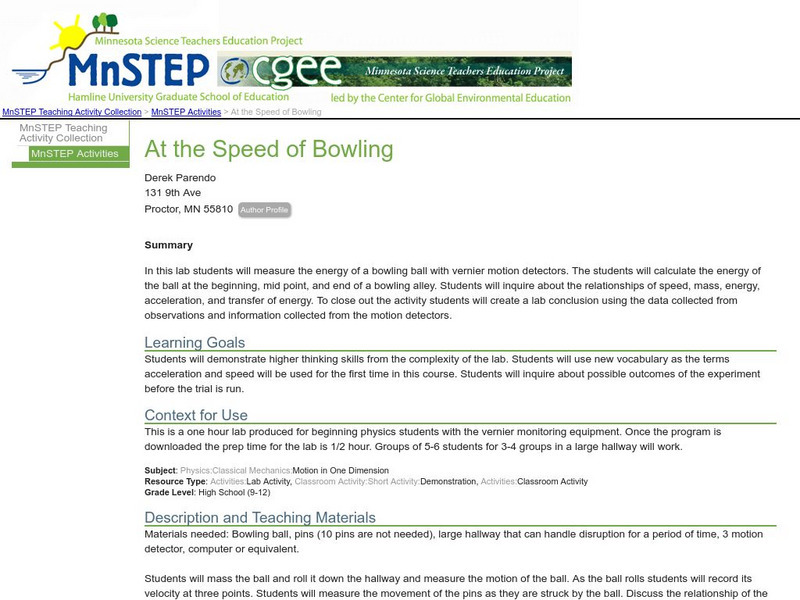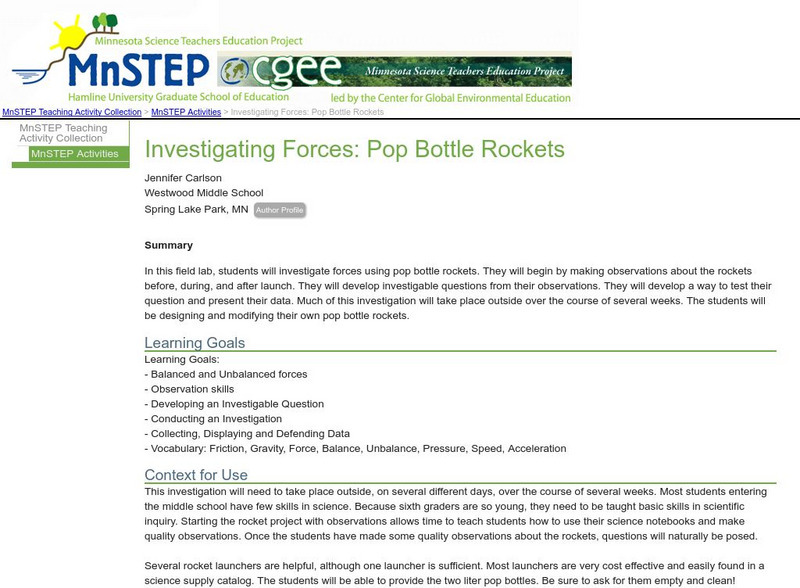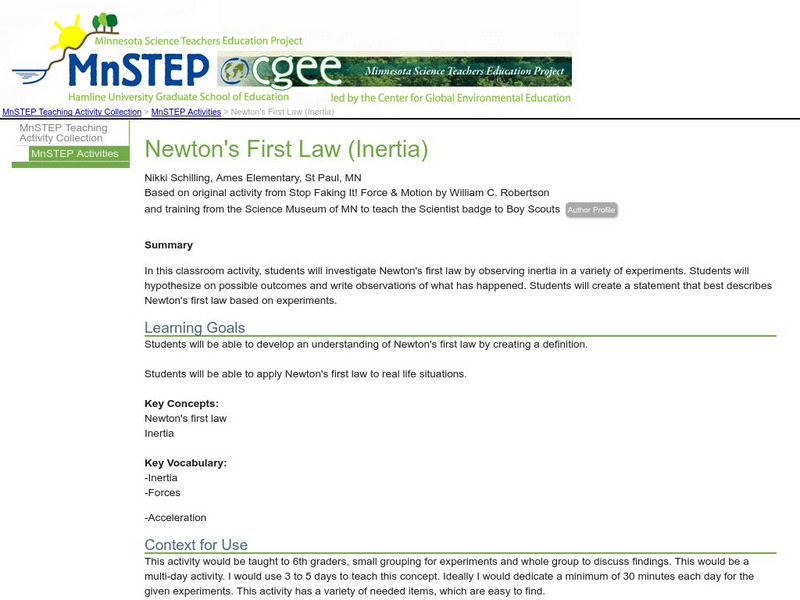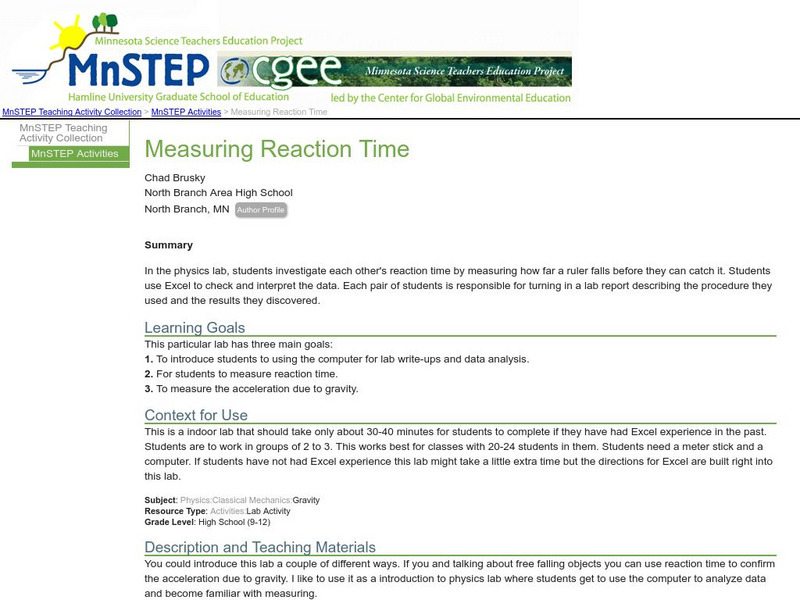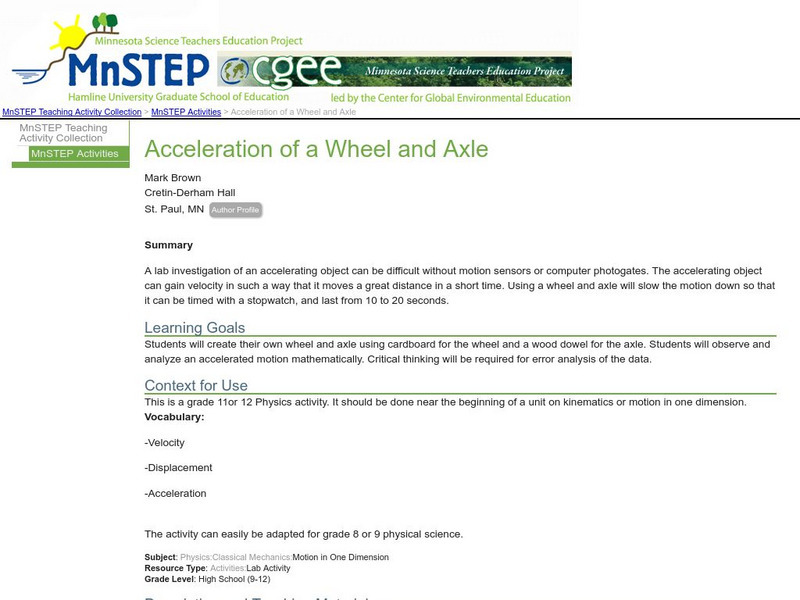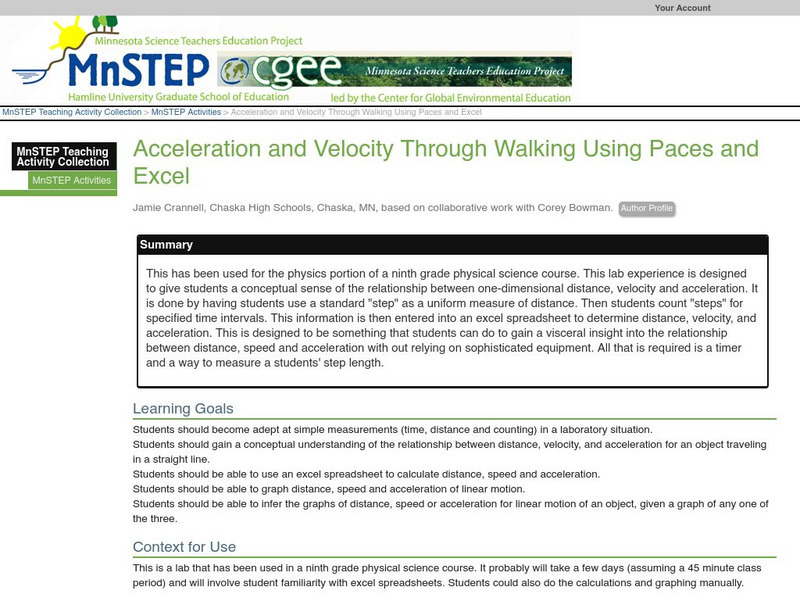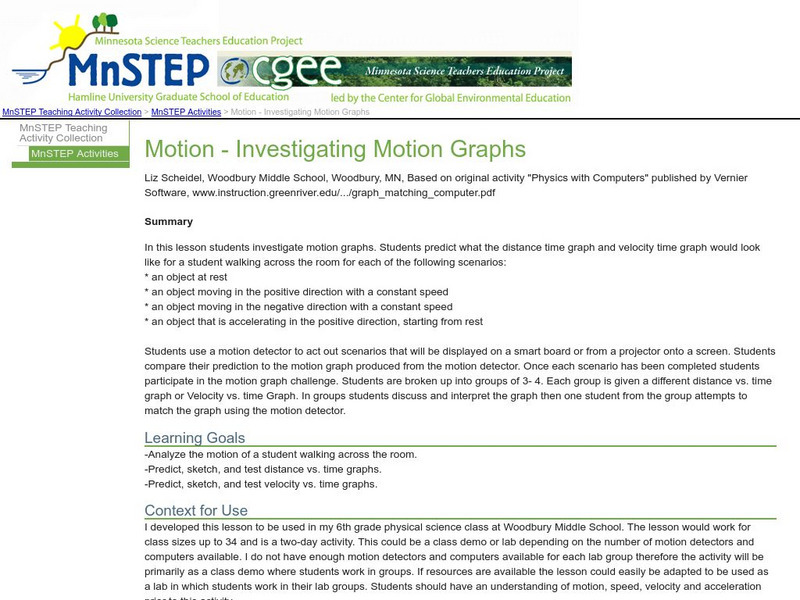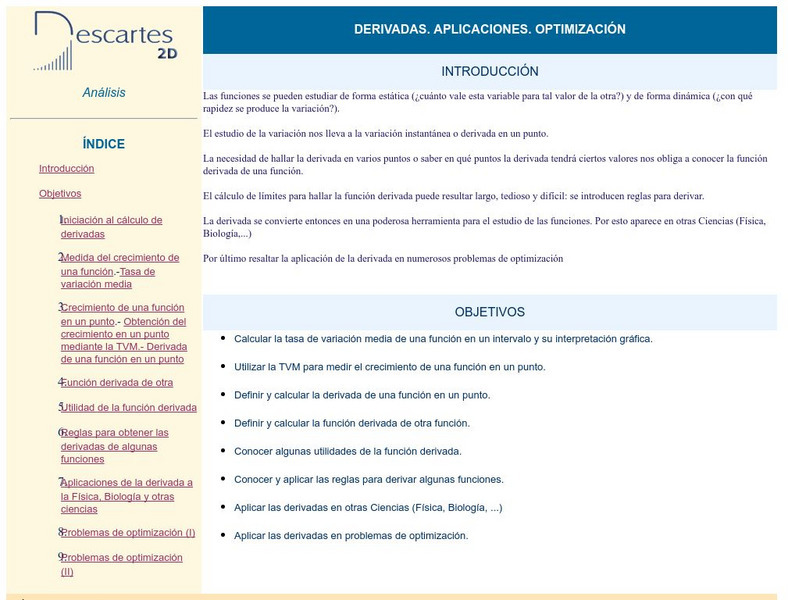Science Education Resource Center at Carleton College
Serc: At the Speed of Bowling
In this lab students will measure the energy of a bowling ball with vernier motion detectors. The students will calculate the energy of the ball at the beginning, mid point, and end of a bowling alley. Students will inquire about the...
Science Education Resource Center at Carleton College
Serc: Newton's Second Law: Constant Force Applied to a Skateboarder
In this lab activity, students will become familiar with Newton's 2nd Law of Motion. By investigating the motion of different skateboarders pulled with a variety of constant force values, they will discover that bodies acted on by a...
Science Education Resource Center at Carleton College
Serc: Investigating Forces: Pop Bottle Rockets
In this lab, students will work on scientific inquiry skills: observation, developing questions, conducting an experiment, and collecting data. They will investigate forces using pop bottle rockets that they have designed.
Science Education Resource Center at Carleton College
Serc: Analyzing Forces and Motion Graphs by Riding an Elevator
A high school physics lab on classical mechanics in which young scholars study force versus time and acceleration versus time. Students need access to an elevator to complete the experiments. A lab handout is provided.
Science Education Resource Center at Carleton College
Serc: Newton's First Law (Inertia)
This activity provides students an opportunity to investigate Newton's first law by observing inertia in a variety of experiments. Students will hypothesize on possible outcomes, write observations of what has happened, and apply...
Science Education Resource Center at Carleton College
Serc: Measuring Reaction Time
Students investigate each other's reaction time by measuring how far a ruler falls before they can catch it. They will interpret the data and turn in a lab report describing the procedure they used and the results they discovered.
Science Education Resource Center at Carleton College
Serc: Acceleration of a Wheel and Axle
A lab investigation of an accelerating object can be difficult without motion sensors or computer photogates. The accelerating object can gain velocity in such a way that it moves a great distance in a short time.
Science Education Resource Center at Carleton College
Serc: Direction of Acceleration
In this short lab, students use Tonka trucks to observe the acceleration of a object as it initiates acceleration, maintains a steady speed, and slows to a stop.
Science Education Resource Center at Carleton College
Serc: Investigating Speed and Constant Acceleration
Students roll miniature cars down a ramp and measure their speed and acceleration every 10 cm. Students can vary the type of car, height of ramp or the ramp material. Student change one of these variables to investigate how the car's...
Science Education Resource Center at Carleton College
Serc: Maximizing Kinetic Energy: An Investigation Using Marbles
Using marbles to construct a marble run, learners will learn about projectile motion, kinetic energy, potential energy, final velocity, and forces.
Science Education Resource Center at Carleton College
Serc: Analyzing the Motion of a Marble Down a Ramp
This lab activity involves rolling a marble down a ramp where the students can investigate constant acceleration motion. The students then make a position vs. time graph and a velocity vs. time graph in order to investigate the change in...
Science Education Resource Center at Carleton College
Serc: Acceleration and Velocity Through Walking Using Paces and Excel
This has been used for the physics portion of a ninth grade physical science course. This lab experience is designed to give students a conceptual sense of the relationship between one-dimensional distance, velocity and acceleration.
Science Education Resource Center at Carleton College
Serc: Motion: Investigating Motion Graphs
In this lesson, students investigate motion graphs. Students predict what the distance-time graph and velocity time graph would look like for a student walking across the room for three different scenarios.
Science Education Resource Center at Carleton College
Serc: Centripetal Force Activity
In this physics activity, young scholars will simulate a race car on a circular track. Velocity, acceleration, and force vectors will be analyzed at various places along the track. As the students progress in the activity, prompts for...
Science Education Resource Center at Carleton College
Serc: Newton's Second: Having a Ball With Motion
Students will create a gravity ball launcher to demonstrate their understanding of mass, force, momentum, and motion. The students will use critical thinking, measurement, and observation and analysis of data to make changes and improve...
Science Education Resource Center at Carleton College
Serc: Egg Drop
In this physics lab, students build a container to safely deliver two eggs from the top of the school. Students calculate average velocity, acceleration, momentum, and the amount of force as it hits the ground. If their egg breaks, they...
Science Education Resource Center at Carleton College
Serc: Force and Motion: Gravity and Wind Resistance
Students investigate the effects of force on objects in motion particularly as it relates to gravity and wind resistance by performing a classroom egg-drop activity.
Science Education Resource Center at Carleton College
Serc: Projectile Motion and Gravity
In this lab, learners will investigate how gravity affects an object that falls from a state of rest and how it affects an object that is projected outward from the same level at the same time. Students will observe the objects and...
Science Education Resource Center at Carleton College
Serc: Investigating Speed and Velocity
In this investigation, middle schoolers will work in groups to design a model roller coaster, which will be used to clock the fastest speed for the rider (ball bearing/marble) The groups will build roller coaster models and modify and...
Science Education Resource Center at Carleton College
Serc: Graph Predictions for Position, Velocity and Acceleration
Learners interactively create predictions of position, velocity, and acceleration graphs using java applets. The applets automatically classify student answers, so instructors can create graphs of student predictions.
Wikimedia
Wikipedia: Centripetal Force
Wikipedia's site on centripetal force provides a section explaining the difference between centripetal force and centrifugal force. Includes formulas and hyperlinked terms.
Ministry of Education and Universities of the Region of Murcia (Spain)
Ministerio De Educacion Y Ciencia: Derivadas. Aplicaciones. Optimizacion.
In Spanish. This interactive unit is intended to show you how to calculate the derivative of a function and the application of the derivative in other sciences.
Physics Classroom
The Physics Classroom: 1 D Kinematics: Table of Contents
Learners examine motion with words, equations, diagrams, and graphs. Some topics investigated are position, velocity, acceleration, and free fall. The tutorial consists of lessons and problems to check for understanding.
Ministry of Education and Universities of the Region of Murcia (Spain)
Ministerio De Educacion Y Ciencia: Derivadas Laterales
This interactive unit is intended to show by graphing and calculations, the elements involved in the study of the growth of a functions and its relation to the definition of derivative.


